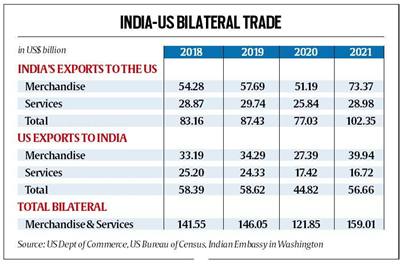Why in News?
- Prime Minister Narendra Modi has headed to the United States for an official state visit on the invitation of President Joe Biden.
What’s in Today’s Article?
- Introduction (About Indo-US Relations)
- India-US Bilateral Relationship (Trade, Security, Strategic, Challenges, etc.)
- Conclusion
Introduction:
- At the heart of the Indo-US strategic partnership is the deepening economic engagement.
- India's largest trading partner is the US and it is also one of the few countries with which India had a trade surplus in 2022-23.
- For the US, India is the ninth largest trading partner.
- India's major exports to the US include gems and jewelry, pharmaceutical products, light crude oil and petroleum, electrical and electronics goods, engineering products, apparel, frozen marine products, and others.
India-US Bilateral Trade Relationship:

- In 2022-23, the bilateral trade between India and the USA stood at a record US$ 191 billion as against US$ 119.42 billion in 2021-22.
- In 2021-22, India had a trade surplus of US$ 32.8 billion with the US
- American companies have invested around US$ 60 billion in India in sectors ranging from manufacturing to telecommunications and consumer goods to aerospace.
- And Indian companies have put in more than US$ 40 billion in sectors such as IT, pharmaceuticals, and green energy.
- In February, Air India announced the purchase of more than 200 Boeing aircrafts — a deal which is said to be the largest order placed by an airline in one go anywhere in the world.
India-US Strategic Relationship:
- The two governments are pursuing more than 50 bilateral dialogue mechanisms at various levels.
- Quadrilateral Security Dialogue –
- The Quad began as a broad partnership after the 2004 Indian Ocean tsunami, but gained strategic heft after the four-country grouping, which has Australia and Japan alongside India and the US.
- It was repurposed in 2017, primarily as a counter to China’s growing influence in the Indian Ocean rim, and as a forum for redoubling focus on the Indo-Pacific region.
- I2U2 –
- The I2U2 is a grouping of India, Israel, the US and the United Arab Emirates.
- It is focused on joint investments and new initiatives in water, energy, transportation, space, health, and food security.
- Initiative on Critical and Emerging Technology (iCET) –
- This January, National Security Advisor Ajit Doval and his US counterpart Jake Sullivan launched a new US-India initiative on Critical and Emerging Technologies.
- These emerging technologies include artificial intelligence, quantum computing, semiconductors and wireless telecommunication.
Challenges/Issues w.r.t. India-US Relationship:
- The US still has significant export controls on India (instituted after the 1998 nuclear test), which inhibits the free transfer of technology.
- Among the outstanding trade issues that require resolution are visa delays and the revoking of India’s trade benefits under the Generalized System of Preferences (GSP) programme in 2019.
- The US has complained about India’s trade policy being overly protectionist, especially with regard to entry barriers for foreign investment and unsteady legal rules.
- India has been raising tariffs over the last few years, reversing an earlier policy of lowering tariffs that endured for decades.
- India will likely be pursued to join the trade pillar of the US-led Indo-Pacific Economic Framework (IPEF).
- India has signed up for three pillars of the IPEF — committed to building more resilient supply chains, tapping clean energy opportunities, and combating corruption.
- However, it has opted out of the fourth pillar (trade) citing reservations about the commitments required on environment, labour, digital trade, and public procurement.
- There is growing disquiet within sections of the Union government over India not finding an entry into the Minerals Security Partnership (MSP).
- MSP is a US-led partnership to secure supply chains of critical minerals that is aimed at reducing dependency on China.
- The MSP is learnt to have weighed the possibility of collaborative work on some 150-odd projects and shortlisted a dozen where members are likely to commence work.
Conclusion:
- India-U.S. trade relations have developed into a "global strategic partnership", based on shared democratic values and increasing convergence of interests on bilateral, regional, and global issues.
- Despite the COVID-19 pandemic, India-U.S. cooperation witnessed intense engagement under various bilateral dialogue mechanisms in a wide range of areas such as –
- defence, security, health, trade, economic, science & technology, energy, and people-to-people ties.
- PM Modi’s visit to the US is expected to give India access to critical American technologies the US rarely shares with non-allies, strengthening a new bond that is underpinned by not just global politics but also business and economics.
- Major announcements expected during PM Modi's visit are –
- U.S. approval to General Electric (GE) to manufacture engines in India for its domestically produced fighter jets,
- India's purchase of 31 armed MQ-9B SeaGuardian drones made by General Atomics worth $3 billion, and
- Removal of U.S. obstacles that prevent smoother trade in defence and high technology.









